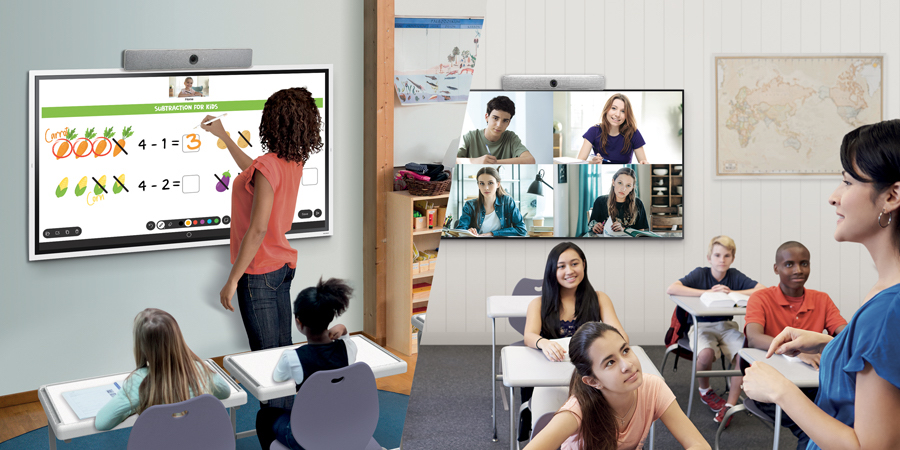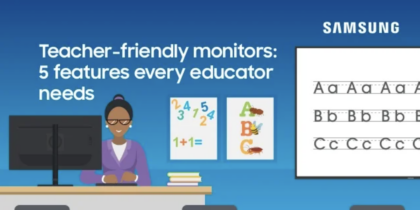Digital-forward educators increasingly embrace new technology that helps their students learn. According to a report for the American Federation of Teachers, 71% of teachers use education technology daily in planning and preparation, and 65% use it for large-group instruction. Not only does that reflect the growing integration of technology in everyone’s lives, but also that teachers spend an increasing amount of time looking at desktop monitors and internet-connected screens to develop lesson plans, take attendance, review curriculum, check emails, fill out report cards and conduct parent-teacher conferences.
The best monitors for teachers can keep up with their jam-packed days and make the job easier. More importantly, they can lead to more positive education outcomes for their students. Here are five factors to look for in the ideal classroom computer monitor.
1. Eye comfort — and health
Classroom screens have become essential in the modern classroom, particularly in remote and hybrid classes. But all of this screen time can cause eye strain and blurred vision. In fact, the American Optometric Association has a name for vision-related issues that result from prolonged screen use, “computer vision syndrome.” The leading causes of this eye strain are insufficient lighting, screen glare, and incorrect viewing distance.
Blended learning without limits
Simple, scalable and secure display solutions empower educators to take control of curriculum. Download Now
The right monitor can go a long way toward improving these symptoms. In addition to adjusting brightness settings and text size, non-glare panes can make a big difference. Another option is choosing a monitor with built-in eye-saver features. These automatically recalibrate the screen’s contrast, brightness and saturation settings for the user’s comfort. Most Samsung monitors, including the 24-inch T45F Borderless IPS Panel Adjustable Professional Monitor, feature Eye Saver Mode, which actively minimizes blue light emissions. Flicker-free technology also continuously removes tiring and irritating screen flicker. The T45F also boasts 178-degree viewing angles, a borderless design — for immersive, seamless viewing — and multiple device ports.
2. Ergonomic design
When teachers work at a desk or with a monitor that is not ergonomically adjusted to suit them, they are more likely to develop musculoskeletal disorders. Choosing flexible, adjustable equipment can help prevent muscle pain, keeping teachers at the top of their game and allowing them to move easily among students to support them better.
Height-adjustable Samsung monitors, for example, can swivel, tilt and pivot in various ways. Teachers can position the screen at the ideal viewing height and angle to see everything more clearly and comfortably.
3. Versatile connectivity
To reach their full potential, monitors need versatile connectivity — essentially, multiple ways to connect to other devices. Multiple input options allow teachers to choose the best connectivity method for a specific purpose, such as to another video device or mirroring another screen. For example, a monitor with a USB-C hub provides multiple connectivity options, including HDMI and standard USB ports, and DisplayPort, a digital and audio interface.
Monitors like Samsung S40UA Panel Borderless Flat Monitor have a USB-C port that can power the monitor and transmit data with a single cable, helping declutter teachers’ desks. The S40UA also has multiple USB ports, so users can plug peripheral devices directly into the monitor.
4. Remote learning features
In remote and hybrid classes, a webcam monitor makes it easier for teachers to handle ongoing online learning. That’s important because 53% of U.S. students take at least one course online in higher education.
With a built-in full high-definition (HD) camera, integrated speakers, and a high-quality microphone, webcam monitors give teachers many options for presenting material. Their wide viewing angles make them ideal for hybrid classrooms, where teachers have both in-person and remote students who need to see the screen at the same time. For the same reason, they’re also effective tools for videoconferencing.
5. Clear, detailed imagery
Teachers may not need the highest-resolution monitor on the market, but a monitor with accurate colors and sharp details still provides concrete benefits.
Higher-resolution screens allow teachers to design and review lesson materials with true-to-life visual accuracy. Samsung HDR10 color technology expands the color spectrum for greater contrast: darker colors appear darker and brighter hues are brighter. With up to 4K UHD resolution and 1 billion colors, HDR10’s color fidelity makes images appear lifelike, a feature that makes a noticeable difference during video calls with remote students and other teachers.
Clarity, flexibility and connectivity: The solution for teachers
Teachers work long hours — much longer than the typical school day. Increasingly, most of these hours are spent looking at screens. Classroom technology should make teaching easier, not harder. Teachers work hard enough as it is; a high-quality monitor can offer much-needed relief.
Explore professional monitor solutions by Samsung to find the perfect monitor for your school’s space, budget and educational needs. Also, learn more about how a curved monitor brings ergonomic benefits and productivity.







